This website is dedicated to English Literature, Literary Criticism, Literary Theory, English Language and its teaching and learning.

“The Story of an Hour” by Kate Chopin: A Critical Analysis
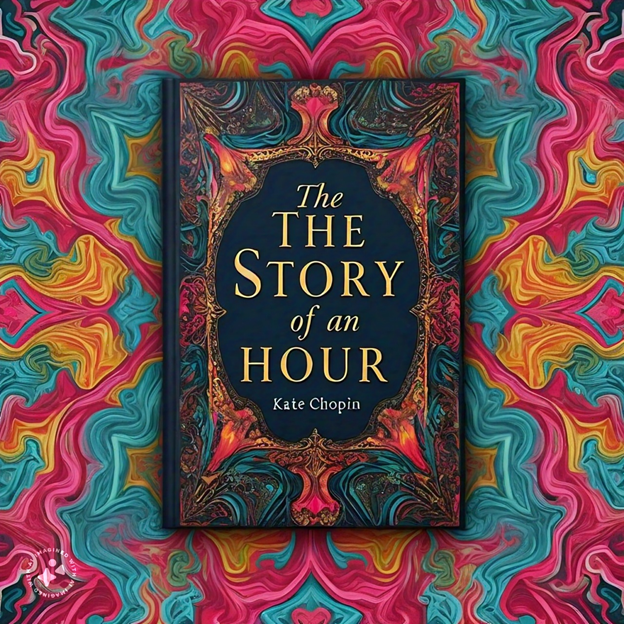
Introduction: “The Story of an Hour” by Kate Chopin
Main Events in “The Story of an Hour” by Kate Chopin
Table of Contents
Literary Devices in “The Story of an Hour” by Kate Chopin
| “railroad accident” | Reference to a common and feared event at the time, evoking a sense of tragedy and shock. | |
| “free, free, free” | Repetition of the word “free” at the beginning of successive clauses emphasizes Louise’s longing for freedom and her triumphant feeling. | |
| “She was young, with a fair, calm face, whose lines bespoke repression and even a certain strength.” | Description of Louise’s physical appearance and personality traits, revealing her inner struggles and resilience. | |
| Contrast | “She had loved him—sometimes. Often she had not.” | Juxtaposition of opposing ideas (love and indifference) highlights the complexity of Louise’s feelings and her mixed emotions. |
| “the delicious breath of rain was in the air” | Vivid description of a sensory experience, creating a sense of freshness and new life, symbolizing Louise’s liberation. | |
| “the joy that kills” | Unexpected twist: Louise’s newfound freedom and joy ultimately lead to her death, highlighting the complexity of her emotions. | |
| “a goddess of Victory” | Comparison of Louise to a triumphant deity, emphasizing her sense of empowerment and freedom. | |
| Freedom | Recurring theme of freedom, emphasizing its significance to Louise and her desire for autonomy. | |
| “the patches of blue sky showing here and there” | Attributing human-like qualities to the sky, creating a sense of hope and freedom. | |
| “free” | Emphasis through repeated use of the word “free”, highlighting Louise’s longing and triumphant feeling. | |
| Open window and blue sky | Representation of freedom, hope, and new life, symbolizing Louise’s liberation from her oppressive marriage. | |
| “the kind, tender hands folded in death” | Using a part (hands) to represent the whole (Brently’s deceased body), emphasizing Louise’s emotional response. | |
| Somber, reflective, and triumphant | Author’s attitude, creating a sense of seriousness, introspection, and ultimately, liberation. | |
| “a monstrous joy” | Words conveying a meaning opposite of their literal definition, highlighting the complexity of Louise’s emotions. | |
| Imagery (Visual) | “the tops of trees that were all aquiver with the new spring life” | Description of settings and characters to create vivid mental images, emphasizing the sense of new life and freedom. |
| “What was it? She did not know; it was too subtle and elusive to name.” | Hinting at events that will occur later (Louise’s death), creating tension and suspense. | |
| “She was beginning to recognize this thing that was approaching to possess her, and she was striving to beat it back with her will—” | Unstructured flow of thoughts and feelings, revealing Louise’s inner turmoil and emotional struggle. | |
| Suspense | “There was something coming to her and she was waiting for it, fearfully.” | Tension created by uncertainty, keeping the reader engaged and invested in Louise’s story. |
| Syntax | Short, simple sentences | Unconventional sentence structure, creating a sense of urgency, simplicity, and directness, emphasizing Louise’s emotions and thoughts. |
Characterization in “The Story of an Hour” by Kate Chopin
Major themes in “the story of an hour” by kate chopin, writing style in “the story of an hour” by kate chopin, literary theories and interpretation of “the story of an hour” by kate chopin.
| Louise’s struggle for autonomy and independence | “There would be no one to live for during those coming years; she would live for herself.” | Louise’s desire for self-assertion and freedom from patriarchal oppression is a central theme. | |
| Louise’s repressed emotions and inner conflict | “She was beginning to recognize this thing that was approaching to possess her, and she was striving to beat it back with her will—” | Louise’s inner turmoil and emotional struggle with her husband’s death reveal her repressed desires and inner conflict. | |
| Symbolic Theory | Symbols of freedom and oppression | “The open window and blue sky” | The open window and blue sky symbolize freedom, hope, and new life, while the closed door and darkness symbolize oppression and confinement. |
Psychoanalytic Theory:
Topics, Questions, and Thesis Statements about “The Story of an Hour” by Kate Chopin
| Gender Roles and Societal Expectations | How does the story challenge traditional gender roles? | In “The Story of an Hour,” Kate Chopin subverts societal expectations by portraying Mrs. Mallard’s reaction to her husband’s death as a complex exploration of liberation and self-assertion. |
| Psychological Realism and Inner Conflict | What psychological insights does the story offer about human emotions and inner conflict? | Through Mrs. Mallard’s internal journey, Chopin provides a nuanced portrayal of human psychology, revealing the complexities of grief, repression, and the pursuit of personal freedom. |
| Irony and Narrative Subversion | How does Chopin use irony to subvert narrative expectations? | Chopin employs irony throughout the story to challenge conventional narrative structures and reveal the unexpected complexities of human experience, particularly in moments of emotional revelation. |
| Symbolism and Subtext | What symbolic elements contribute to the deeper meaning of the story? | The use of symbolism, such as the open window and Mrs. Mallard’s physical confinement, underscores the story’s exploration of liberation, repression, and the struggle for individual identity. |
Short Questions/Answers about/on “The Story of an Hour” by Kate Chopin
Literary works similar to “the story of an hour” by kate chopin, suggested readings about/on “the story of an hour” by kate chopin, books on kate chopin and “the story of an hour”:, articles on “the story of an hour”:, web resource:, representative quotations from “the story of an hour” by kate chopin.
| “She wept at once, with sudden, wild abandonment, in her sister’s arms.” | Louise’s initial reaction to news of her husband’s death | Feminist Theory: highlights the societal expectation of women’s emotional response to tragedy |
| “There were patches of blue sky showing here and there through the clouds…” | Louise’s gaze out the window, symbolizing freedom and hope | Symbolic Theory: the open window and blue sky represent freedom and new life |
| “She was young, with a fair, calm face, whose lines bespoke repression and even a certain strength.” | Description of Louise’s physical appearance and personality | Psychoanalytic Theory: reveals Louise’s repressed emotions and inner conflict |
| “She said it over and over under her breath: ‘free, free, free!'” | Louise’s whispered word, symbolizing her desire for autonomy | Feminist Theory: highlights the importance of individual freedom and autonomy |
| “There would be no one to live for during those coming years; she would live for herself.” | Louise’s realization of her newfound independence | Existentialist Theory: emphasizes individual responsibility and self-assertion |
| “What could love, the unsolved mystery, count for in the face of this possession of self-assertion…” | Louise’s reflection on the significance of love and self-assertion | Psychoanalytic Theory: reveals the tension between societal expectations and individual desires |
| “She breathed a quick prayer that life might be long.” | Louise’s desire for a long and independent life | Existentialist Theory: emphasizes the individual’s desire for life and autonomy |
Related posts:
Leave a reply cancel reply.
Your email address will not be published. Required fields are marked *
Home — Essay Samples — Literature — The Story of An Hour — The Story of an Hour: A Critical Analysis
The Story of an Hour: a Critical Analysis
- Categories: Literature Review The Story of An Hour
About this sample

Words: 603 |
Published: Feb 7, 2024
Words: 603 | Page: 1 | 4 min read
Table of contents
The suppression of mrs. mallard, symbolism and foreshadowing, the irony of the conclusion.

Cite this Essay
To export a reference to this article please select a referencing style below:
Let us write you an essay from scratch
- 450+ experts on 30 subjects ready to help
- Custom essay delivered in as few as 3 hours
Get high-quality help

Verified writer
- Expert in: Literature

+ 120 experts online
By clicking “Check Writers’ Offers”, you agree to our terms of service and privacy policy . We’ll occasionally send you promo and account related email
No need to pay just yet!
Related Essays
2 pages / 685 words
1 pages / 493 words
2 pages / 683 words
2.5 pages / 1208 words
Remember! This is just a sample.
You can get your custom paper by one of our expert writers.
121 writers online
Still can’t find what you need?
Browse our vast selection of original essay samples, each expertly formatted and styled
Related Essays on The Story of An Hour
Often hailed as classics of feminist literature, "The Story of an Hour" by Kate Chopin and "Sweat" by Zora Neale Hurston both employ the literary device of irony to illuminate the oppression, societal expectations, and [...]
First published in 1894, Kate Chopin's "The Story of an Hour" is a short but powerful story that explores the complex emotions of a woman who learns of her husband's death. The narrative delves into the theme of female [...]
Freedom and self-assertion have been significant themes in literature, especially during periods of social change. In Kate Chopin's "The Story of an Hour," the author skillfully employs literary devices to explore the theme of [...]
Berkove, Lawrence "Fatal Self-Assertion in Kate Chopin's 'The Story of an Hour'." American Literary Realism, vol. 32, no. 2, 2000, pp. 152-158. Gilman, Charlotte Perkins. "The Yellow Wallpaper." The New England [...]
In The Story of an Hour, Kate Chopin uses a variety of literary devices ranging from third person narration, juxtaposition and irony to vividly illustrate the dramatic process of grievance, and alternately liberation, that Mrs. [...]
This report demonstrates the analysis of the story The Story of an Hour by Kate Chopin. Focusing on what the prominent themes imply, and how are they relevant to the story. This ironically tragic yet powerful short story was [...]
Related Topics
By clicking “Send”, you agree to our Terms of service and Privacy statement . We will occasionally send you account related emails.
Where do you want us to send this sample?
By clicking “Continue”, you agree to our terms of service and privacy policy.
Be careful. This essay is not unique
This essay was donated by a student and is likely to have been used and submitted before
Download this Sample
Free samples may contain mistakes and not unique parts
Sorry, we could not paraphrase this essay. Our professional writers can rewrite it and get you a unique paper.
Please check your inbox.
We can write you a custom essay that will follow your exact instructions and meet the deadlines. Let's fix your grades together!
Get Your Personalized Essay in 3 Hours or Less!
We use cookies to personalyze your web-site experience. By continuing we’ll assume you board with our cookie policy .
- Instructions Followed To The Letter
- Deadlines Met At Every Stage
- Unique And Plagiarism Free

- Ask LitCharts AI
- Discussion Question Generator
- Essay Prompt Generator
- Quiz Question Generator

- Literature Guides
- Poetry Guides
- Shakespeare Translations
- Literary Terms
The Story of an Hour
Kate chopin.
| Summary & Analysis |
- Quizzes, saving guides, requests, plus so much more.

A Summary and Analysis of Kate Chopin’s ‘The Story of an Hour’
By Dr Oliver Tearle (Loughborough University)
Some short stories can say all they need to do in just a few pages, and Kate Chopin’s three-page 1894 story ‘The Story of an Hour’ (sometimes known as ‘The Dream of an Hour’) is a classic example. Yet those three pages remain tantalisingly ambiguous, perhaps because so little is said, so much merely hinted at. Yet Chopin’s short story is, upon closer inspection, a subtle, studied analysis of death, marriage, and personal wishes.
Written in April 1894 and originally published in Vogue in December of that year, the story focuses on an hour in the life of a married woman who has just learnt that her husband has apparently died.
‘The Story of an Hour’: plot summary
What happens in that brief hour, that story of an hour? A married woman, Mrs Louise Mallard, who has heart trouble, learns that her husband has died in a railroad accident.
Her sister Josephine breaks the news to her; it was her husband’s friend Richards who first heard about the railroad disaster and saw her husband’s name, Brently Mallard, at the top of the list of fatalities. Her first reaction is to weep at the news that her husband is dead; she then takes herself off to her room to be alone.
She sinks into an armchair and finds herself attuned to a series of sensations: the trees outside the window ‘aquiver with the new spring life’, the ‘breath of rain’ in the air; the sound of a peddler crying his wares in the street below. She finds herself going into a sort of trancelike daze, a ‘suspension of intelligent thought’.
Then, gradually, a feeling begins to form within her: a sense of freedom. Now her husband is dead, it seems, she feels free. She dreads seeing her husband’s face (as she knows she must, when she goes to identify the body), but she knows that beyond that lie years and years of her life yet to be lived, and ‘would all belong to her absolutely’.
She reflects that she had loved her husband – sometimes. Sometimes she hadn’t. But now, that didn’t matter: what matters is the ‘self-assertion’, the declaration of independence, that her life alone represents a new start.
But then, her sister Josephine calls from outside the door for her to come out, worried that Louise is making herself ill. But Louise doesn’t feel ill: she feels on top of the world. She used to dread the prospect of living to a ripe old age, but now she welcomes such a prospect. Eventually she opens the door and she and Josephine go back downstairs.
Richards is still down there, waiting for them. Then, there’s a key in the front door and who should enter but … Mrs Mallard’s husband, Brently Mallard.
It turns out he was nowhere near the scene of the railroad accident, and is unharmed! Mrs Mallard is so shocked at his return that she dies, partly because of her heart disease but also, so ‘they’ said, from the unexpected ‘joy’ of her husband’s return.
‘The Story of an Hour’: analysis
In some ways, ‘The Story of an Hour’ prefigures a later story like D. H. Lawrence’s ‘ Odour of Chrysanthemums ’ (1911), which also features a female protagonist whose partner’s death makes her reassess her life with him and to contemplate the complex responses his death has aroused in her.
However, in Lawrence’s story the husband really has died (in a mining accident), whereas in ‘The Story of an Hour’, we find out at the end of the story that Mr Mallard was not involved in the railroad accident and is alive and well. In a shock twist, it is his wife who dies, upon learning that he is still alive.
What should we make of this ‘dream of an hour’? That alternative title is significant, not least because of the ambiguity surrounding the word ‘dream’. Is Louise so plunged into shock by the news of her husband’s apparent death that she begins to hallucinate that she would be better off without him? Is this her way of coping with traumatic news – to try to look for the silver lining in a very black cloud? Or should we analyse ‘dream’ as a sign that she entertains aspirations and ambitions, now her husband is out of the way?
‘The Dream of an Hour’ perhaps inevitably puts us in mind of Kate Chopin’s most famous story, the short novel The Awakening (1899), whose title reflects its female protagonist Edna Pontellier’s growing awareness that there is more to life than her wifely existence.
But Louisa Mallard’s ‘awakening’ remains a dream; when she awakes from it, upon learning that her husband is still alive and all her fancies about her future life have been in vain, she dies.
‘The Story of an Hour’ and modernism
‘The Story of an Hour’ is an early example of the impressionistic method of storytelling which was also being developed by Anton Chekhov around the same time as Chopin, and which would later be used by modernists such as Katherine Mansfield, James Joyce, and Virginia Woolf.
Although the story uses an omniscient third-person narrator, we are shown things from particular character perspectives in a way that reflects their own confusions and erratic thoughts – chiefly, of course, Louisa Mallard’s own.
But this impressionistic style – which is more interested in patterns of thought, daydreaming, and emotional responses to the world than in tightly structured plots – continues right until the end of the story.
Consider the final sentence of the story: ‘When the doctors came they said she had died of heart disease – of joy that kills.’ The irony, of course, is that Louisa appears to have accepted her husband’s death and to have taken his demise as a chance to liberate herself from an oppressive marriage (note Chopin’s reference to the lines on her face which ‘bespoke repression and even a certain strength’ – what did she need that strength for, we wonder?).
So it was not joy but disappointment, if anything, that brought on the heart attack that killed her. But the (presumably male) doctors who attended her death would not have assumed any such thing: they would have analysed her death as a result of her love for her husband, and the sheer joy she felt at having him back.
Chopin’s story also foreshadows Katherine Mansfield’s ‘The Garden Party’ , and Laura Sheridan’s enigmatic emotional reaction to seeing her first dead body (as with Chopin’s story, a man who has died in an accident). If you enjoyed this analysis of ‘The Story of an Hour’, you might also enjoy Anton Chekhov’s 1900 story ‘At Christmas Time’, to which Chopin’s story has been compared.
Discover more from Interesting Literature
Subscribe to get the latest posts sent to your email.
Type your email…
Leave a Reply Cancel reply
Subscribe now to keep reading and get access to the full archive.
Continue reading
Literary Theory and Criticism
Home › Literature › Analysis of Kate Chopin’s The Story of an Hour
Analysis of Kate Chopin’s The Story of an Hour
By NASRULLAH MAMBROL on July 28, 2021
Originally entitled “The Dream of an Hour” when it was first published in Vogue (December 1894), “The Story of an Hour” has since become one of Kate Chopin’s most frequently anthologized stories. Among her shortest and most daring works, “Story” examines issues of feminism, namely, a woman’s dissatisfaction in a conventional marriage and her desire for independence. It also features Chopin’s characteristic irony and ambiguity .
The story begins with Louise Mallard’s being told about her husband’s presumed death in a train accident. Louise initially weeps with wild abandon, then retires alone to her upstairs bedroom. As she sits facing the open window, observing the new spring life outside, she realizes with a “clear and exalted perception” that she is now free of her husband’s “powerful will bending hers” (353). She becomes delirious with the prospect that she can now live for herself and prays that her life may be long. Her newfound independence is short-lived, however. In a surprise ending, her husband walks through the front door, and Louise suffers a heart attack and dies. Her death may be considered a tragic defeat or a pyrrhic victory for a woman who would rather die than lose that “possession of self-assertion which she suddenly recognized as the strongest impulse of her being” (353). The doctors ironically attribute her death to the “joy that kills” (354).
BIBLIOGRAPHY Chopin, Kate. The Complete Works of Kate Chopin. Edited by Per Seyersted. Baton Rouge: Louisiana State University Press, 1969. Koloski, Bernard. Kate Chopin: A Study of the Short Fiction. New York: Twayne, 1996. Seyersted, Per. Kate Chopin: A Critical Biography. Baton Rouge: Louisiana State University Press, 1969. Toth, Emily. Kate Chopin. New York: Morrow, 1990

Share this:
Categories: Literature , Short Story
Tags: American Literature , Analysis of Kate Chopin's The Story of an Hour , calicut university materials of Kate Chopin's The Story of an Hour , criticism of Kate Chopin's The Story of an Hour , Kate Chopin , Kate Chopin's The Story of an Hour , Kate Chopin's The Story of an Hour criticism , Kate Chopin's The Story of an Hour essay , Kate Chopin's The Story of an Hour notes , Kate Chopin's The Story of an Hour plot , Literary Criticism , plotKate Chopin's The Story of an Hour , summary of Kate Chopin's The Story of an Hour , The Dream of an Hour , themes of Kate Chopin's The Story of an Hour
Related Articles

You must be logged in to post a comment.

Kate Chopin’s “The Story of an Hour” Essay (Review)
Introduction, works cited.
This paper will provide a summary and an analysis of “The Story of an Hour,” a short story by Kate Chopin published in 1894. Despite being only several pages long, the passage has become popular among readers. The title refers to the fact that the plot revolves around a woman and what she experiences throughout one hour. Within several pages, Kate Chopin managed to encompass the themes of freedom and oppression, simultaneously using irony.
Mrs. Mallard, the protagonist of the story, learns that her husband died as a result of a train accident. At first, the woman starts grieving, but as she spends minutes in solitude, she comes to the realization that she is now free (Chopin). The death of her husband, although an adverse event, is to bring positive items, such as independence. Mrs. Mallard understands that the rest of the life she has will be spent the way she wants (Chopin). After this insight, the woman feels happier, and the sadness is gone. Having spent some moments dreaming of a long life in freedom, she comes down the stairs only to see her husband enter the house alive and safe (Chopin). Mrs. Mallard has a heart stroke and dies, and doctors conclude that the extreme happiness of seeing her husband alive caused the death.
Despite being the right of every person, freedom is an expensive privilege. African Americans have fought for centuries to end slavery, while women are still struggling to enjoy the same conditions as men. In the 19th century, women’s rights were not the same as today, and independence was non-existent. Chopin’s story reflects this fact – Mrs. Mallard utters the word “free” when she is alone in her room. For women of those times, freedom was not the topic to discuss in public. It was almost a taboo subject to talk about with others.
The joy of being independent was only felt by men, which is why Mrs. Mallard thought no one would understand and accept her happiness. Therefore, she continues to dream about her future alone without her husband. In the beginning, she attempts to resist the favorable feelings she is having. This fact indicates that for women, freedom and equal rights were forbidden fruit. After excitement fills her, Mrs. Mallard starts praying for long life and planning how she will spend the time that is now hers entirely. He suggests that the story reflects the struggles of women of those times in achieving their modern ethical identities (2). In other words, rights and privileges that are enjoyed by women of the 21st century were non-existent for women several centuries ago, and one needs to embrace these hard-won rights.
Another interesting point to consider is the fact that Mrs. Mallard is joyful even though she did not feel animosity toward her husband. In fact, she admits that her marriage was happy, and her husband loved her and was kind. Nevertheless, Mrs. Mallard becomes uplifted despite crying in the beginning. One may suggest that the writer wants to indicate that all marriages are oppressive in nature. Women have to part with their time and independence in order to care for their husbands and children, whereas men have to spend their lives working in order to provide for their families. However, Chopin does not give any specific examples of why marriages are oppressive. Instead, she states that unions are inherently burdensome for both men and women. The news of Mr. Mallard’s death releases the protagonist from this burden. After she realizes that her marriage persists, the woman has a shock that leads to death.
The nature of her weeping supports the idea that marriages are oppressive. Mrs. Mallard cries when she thinks of her husband, but as soon as she starts thinking of independence, it is replaced with joy. In other words, life with her husband is associated with tears and sorrow, while thoughts of freedom immediately bring happiness. This transition represents the contrast between oppressive marriage and delightful independence.
There is an ironic moment that is important to consider. Doctors that arrive to inspect Mrs. Mallard after she dies inform her that the woman died because of the joy of seeing her husband alive. This moment is ironic because doctors in the 19th century were mostly men. Men would never realize that women need independence in the same way as them. It would never occur to a male doctor that the woman died because she lost her newly acquired freedom. This irony reinforces the fact that women had to speak and demand and equal rights would not have been achieved otherwise. Only through continuous struggles and fights, it was possible for women to achieve the comforts enjoyed today.
“The Story of an Hour” is one of the most famous works of Kate Chopin. This short reading narrates the story of a woman that feels optimistic about her husband’s death as she realizes that the rest of her life can be spent in freedom. Kate Chopin wanted to explain that all marriages are oppressive by nature for both women and men, and independence is desired by all women, which the author explicitly highlighted by using the bitter irony.
Chopin, Kate. “The Story of an Hour.” The Kate Chopin International Society ¸ 2020.
Hu, Aihua. “The Story of an Hour: Mrs. Mallard’s Ethically Tragic Song.” ANQ: A Quarterly Journal of Short Articles, Notes and Reviews , 2020, pp. 1-7.
- “The Most Dangerous Job” by Schlosser
- The Making of a Hero: Jefferson in A Lesson Before Dying. Ernest J. Gaines
- The Story of an Hour by Kate Chopin: Novel Analysis
- Trifles by Susan Glaspell and The Story of an Hour by Kate Chopin’s
- “The Story of an Hour” by Kate Chopin: The Main Goals and Themes
- Terrorism and Trauma in American Literature
- The Rejection in the Tell-Tale Heart by Edgar Allan Poe
- John Steinbeck’s “Cannery Row” Novel Analysis
- “The Scarlet Ibis” by James Hurst
- “The Black Cat” by Edgar Allan Poe
- Chicago (A-D)
- Chicago (N-B)
IvyPanda. (2022, February 21). Kate Chopin’s “The Story of an Hour”. https://ivypanda.com/essays/kate-chopins-the-story-of-an-hour-essay/
"Kate Chopin’s “The Story of an Hour”." IvyPanda , 21 Feb. 2022, ivypanda.com/essays/kate-chopins-the-story-of-an-hour-essay/.
IvyPanda . (2022) 'Kate Chopin’s “The Story of an Hour”'. 21 February.
IvyPanda . 2022. "Kate Chopin’s “The Story of an Hour”." February 21, 2022. https://ivypanda.com/essays/kate-chopins-the-story-of-an-hour-essay/.
1. IvyPanda . "Kate Chopin’s “The Story of an Hour”." February 21, 2022. https://ivypanda.com/essays/kate-chopins-the-story-of-an-hour-essay/.
Bibliography
IvyPanda . "Kate Chopin’s “The Story of an Hour”." February 21, 2022. https://ivypanda.com/essays/kate-chopins-the-story-of-an-hour-essay/.
- To find inspiration for your paper and overcome writer’s block
- As a source of information (ensure proper referencing)
- As a template for you assignment
IvyPanda uses cookies and similar technologies to enhance your experience, enabling functionalities such as:
- Basic site functions
- Ensuring secure, safe transactions
- Secure account login
- Remembering account, browser, and regional preferences
- Remembering privacy and security settings
- Analyzing site traffic and usage
- Personalized search, content, and recommendations
- Displaying relevant, targeted ads on and off IvyPanda
Please refer to IvyPanda's Cookies Policy and Privacy Policy for detailed information.
Certain technologies we use are essential for critical functions such as security and site integrity, account authentication, security and privacy preferences, internal site usage and maintenance data, and ensuring the site operates correctly for browsing and transactions.
Cookies and similar technologies are used to enhance your experience by:
- Remembering general and regional preferences
- Personalizing content, search, recommendations, and offers
Some functions, such as personalized recommendations, account preferences, or localization, may not work correctly without these technologies. For more details, please refer to IvyPanda's Cookies Policy .
To enable personalized advertising (such as interest-based ads), we may share your data with our marketing and advertising partners using cookies and other technologies. These partners may have their own information collected about you. Turning off the personalized advertising setting won't stop you from seeing IvyPanda ads, but it may make the ads you see less relevant or more repetitive.
Personalized advertising may be considered a "sale" or "sharing" of the information under California and other state privacy laws, and you may have the right to opt out. Turning off personalized advertising allows you to exercise your right to opt out. Learn more in IvyPanda's Cookies Policy and Privacy Policy .

Choose Your Test
- Search Blogs By Category
- College Admissions
- AP and IB Exams
- GPA and Coursework
The Story of an Hour: Summary and Analysis
General Education
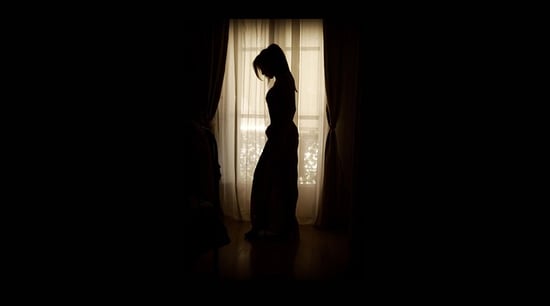
Imagine a world where women are fighting for unprecedented rights, the economic climate is unpredictable, and new developments in technology are made every year. While this world might sound like the present day, it also describes America in the 1890s .
It was in this world that author Kate Chopin wrote and lived, and many of the issues of the period are reflected in her short story, “The Story of an Hour.” Now, over a century later, the story remains one of Kate Chopin’s most well-known works and continues to shed light on the internal struggle of women who have been denied autonomy.
In this guide to Kate Chopin’s “The Story of an Hour,” we’ll discuss:
- A brief history of Kate Chopin and America the 1890s
- “The Story of an Hour” summary
- Analysis of the key story elements in “The Story of an Hour,” including themes, characters, and symbols
By the end of this article, you’ll have an expert grasp on Kate Chopin’s “The Story of an Hour.” So let’s get started!
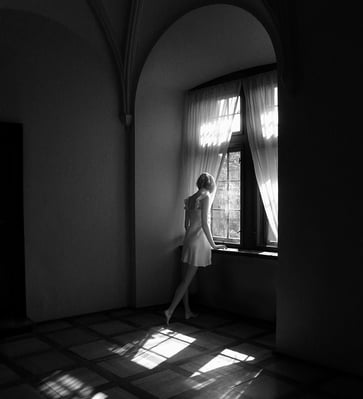
“The Story of an Hour” Summary
If it’s been a little while since you’ve read Kate Chopin’s “The Story of an Hour,” it can be hard to remember the important details. This section includes a quick recap, but you can find “The Story of an Hour” PDF and full version here . We recommend you read it again before diving into our analyses in the next section!
For those who just need a refresher, here’s “The Story of an Hour” summary:
Mrs. Louise Mallard is at home when her sister, Josephine, and her husband’s friend, Richards, come to tell her that her husband, Brently Mallard, has been killed in a railroad accident . Richards had been at the newspaper office when the news broke, and he takes Josephine with him to break the news to Louise since they’re afraid of aggravating her heart condition. Upon hearing the news of her husband’s death, Louise is grief-stricken, locks herself in her room, and weeps.
From here, the story shifts in tone. As Louise processes the news of her husband’s death, she realizes something wonderful and terrible at the same time: she is free . At first she’s scared to admit it, but Louise quickly finds peace and joy in her admission. She realizes that, although she will be sad about her husband (“she had loved him—sometimes,” Chopin writes), Louise is excited for the opportunity to live for herself. She keeps repeating the word “free” as she comes to terms with what her husband’s death means for her life.
In the meantime, Josephine sits at Louise’s door, coaxing her to come out because she is worried about Louise’s heart condition. After praying that her life is long-lived, Louise agrees to come out. However, as she comes downstairs, the front door opens to reveal her husband, who had not been killed by the accident at all. Although Richards tries to keep Louise’s heart from shock by shielding her husband from view, Louise dies suddenly, which the doctors later attribute to “heart disease—of the joy that kills .”
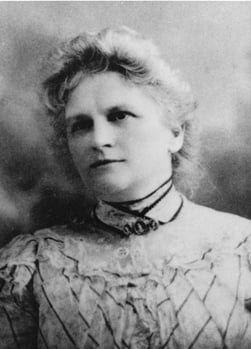
Kate Chopin, the author of "The Story of an Hour," has become one of the most important American writers of the 19th century.
The History of Kate Chopin and the 1890s
Before we move into “The Story of an Hour” analysis section, it’s helpful to know a little bit about Kate Chopin and the world she lived in.
A Short Biography of Kate Chopin
Born in 1850 to wealthy Catholic parents in St. Louis, Missouri, Kate Chopin (originally Kate O’Flaherty) knew hardship from an early age. In 1855, Chopin lost her father, Thomas, when he passed away in a tragic and unexpected railroad accident. The events of this loss would stay with Kate for the rest of her life, eventually becoming the basis for “The Story of an Hour” nearly forty years later.
Chopin was well-educated throughout her childhood , reading voraciously and becoming fluent in French. Chopin was also very aware of the divide between the powerful and the oppressed in society at the time . She grew up during the U.S. Civil War, so she had first-hand knowledge of violence and slavery in the United States.
Chopin was also exposed to non-traditional roles for women through her familial situation. Her mother, grandmother, and great-grandmother chose to remain widows (rather than remarry) after their husbands died. Consequently, Chopin learned how important women’s independence could be, and that idea would permeate much of her writing later on.
As Chopin grew older, she became known for her beauty and congeniality by society in St. Louis. She was married at the age of nineteen to Oscar Chopin, who came from a wealthy cotton-growing family. The couple moved to New Orleans, where they would start both a general store and a large family. (Chopin would give birth to seven children over the next nine years!)
While Oscar adored his wife, he was less capable of running a business. Financial trouble forced the family to move around rural Louisiana. Unfortunately, Oscar would die of swamp fever in 1882 , leaving Chopin in heavy debt and with the responsibility of managing the family’s struggling businesses.
After trying her hand at managing the property for a year, Chopin conceded to her mother’s requests to return with her children to St. Louis. Chopin’s mother died the year after. In order to support herself and her children, Kate began to write to support her family.
Luckily, Chopin found immediate success as a writer. Many of her short stories and novels—including her most famous novel, The Awakening— dealt with life in Louisiana . She was also known as a fast and prolific writer, and by the end of the 1900s she had written over 100 stories, articles, and essays.
Unfortunately, Chopin would pass away from a suspected cerebral hemorrhage in 1904, at the age of 54 . But Kate Chopin’s “The Story of an Hour” and other writings have withstood the test of time. Her work has lived on, and she’s now recognized as one of the most important American writers of the 19th century.
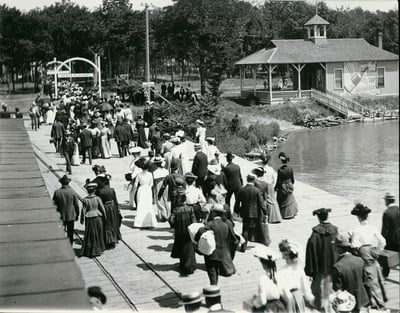
American life was undergoing significant change in the 19th century. Technology, culture, and even leisure activities were changing.
American Life in the 1890s
“The Story of an Hour” was written and published in 1894, right as the 1800s were coming to a close. As the world moved into the new century, American life was also changing rapidly.
For instance, t he workplace was changing drastically in the 1890s . Gone were the days where most people were expected to work at a trade or on a farm. Factory jobs brought on by industrialization made work more efficient, and many of these factory owners gradually implemented more humane treatment of their workers, giving them more leisure time than ever.
Though the country was in an economic recession at this time, technological changes like electric lighting and the popularization of radios bettered the daily lives of many people and allowed for the creation of new jobs. Notably, however, work was different for women . Working women as a whole were looked down upon by society, no matter why they found themselves in need of a job.
Women who worked while they were married or pregnant were judged even more harshly. Women of Kate Chopin’s social rank were expected to not work at all , sometimes even delegating the responsibility of managing the house or child-rearing to maids or nannies. In the 1890s, working was only for lower class women who could not afford a life of leisure .
In reaction to this, the National American Woman Suffrage Association was created in 1890, which fought for women’s social and political rights. While Kate Chopin was not a formal member of the suffragette movements, she did believe that women should have greater freedoms as individuals and often talked about these ideas in her works, including in “The Story of an Hour.”
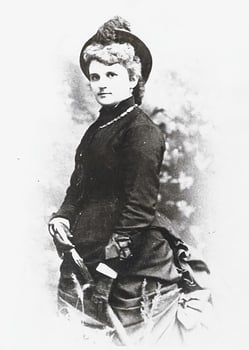
Kate Chopin's "The Story of an Hour" a short exploration of marriage and repression in America.
“The Story of an Hour” Analysis
Now that you have some important background information, it’s time to start analyzing “The Story of an Hour.”
This short story is filled with opposing forces . The themes, characters, and even symbols in the story are often equal, but opposite, of one another. Within “The Story of an Hour,” analysis of all of these elements reveals a deeper meaning.
“The Story of an Hour” Themes
A theme is a message explored in a piece of literature. Most stories have multiple themes, which is certainly the case in “The Story of an Hour.” Even though Chopin’s story is short, it discusses the thematic ideas of freedom, repression, and marriage.
Keep reading for a discussion of the importance of each theme!
Freedom and Repression
The most prevalent theme in Chopin’s story is the battle between freedom and “repression.” Simply put , repression happens when a person’s thoughts, feelings, or desires are being subdued. Repression can happen internally and externally. For example, if a person goes through a traumatic accident, they may (consciously or subconsciously) choose to repress the memory of the accident itself. Likewise, if a person has wants or needs that society finds unacceptable, society can work to repress that individual. Women in the 19th century were often victims of repression. They were supposed to be demure, gentle, and passive—which often went against women’s personal desires.
Given this, it becomes apparent that Louise Mallard is the victim of social repression. Until the moment of her husband’s supposed death, Louise does not feel free . In their marriage, Louise is repressed. Readers see this in the fact that Brently is moving around in the outside world, while Louise is confined to her home. Brently uses railroad transportation on his own, walks into his house of his own accord, and has individual possessions in the form of his briefcase and umbrella. Brently is even free from the knowledge of the train wreck upon his return home. Louise, on the other hand, is stuck at home by virtue of her position as a woman and her heart condition.
Here, Chopin draws a strong contrast between what it means to be free for men and women. While freedom is just part of what it means to be a man in America, freedom for women looks markedly different. Louise’s life is shaped by what society believes a woman should be and how a wife should behave. Once Louise’s husband “dies,” however, she sees a way where she can start claiming some of the more “masculine” freedoms for herself. Chopin shows how deeply important freedom is to the life of a woman when, in the end, it’s not the shock of her husband’s return of her husband that kills Louise, but rather the thought of losing her freedom again.
Marriage as a “The Story of an Hour” theme is more than just an idyllic life spent with a significant other. The Mallard’s marriage shows a reality of 1890s life that was familiar to many people. Marriage was a means of social control —that is to say, marriage helped keep women in check and secure men’s social and political power. While husbands were usually free to wander the world on their own, hold jobs, and make important family decisions, wives (at least those of the upper class) were expected to stay at home and be domestic.
Marriage in Louise Mallard’s case has very little love. She sees her marriage as a life-long bond in which she feels trapped, which readers see when she confesses that she loved her husband only “sometimes.” More to the point, she describes her marriage as a “powerful will bending hers in that blind persistence with which men and women believe they have a right to impose a private will upon a fellow-creature.” In other words, Louise Mallard feels injustice in the expectation that her life is dictated by the will of her husband.
Like the story, the marriages Kate witnessed often ended in an early or unexpected death. The women of her family, including Kate herself, all survived their husbands and didn’t remarry. While history tells us that Kate Chopin was happy in her marriage, she was aware that many women weren’t. By showing a marriage that had been built on control and society’s expectations, Chopin’s “The Story of an Hour” highlights the need for a world that respected women as valuable partners in marriage as well as capable individuals.
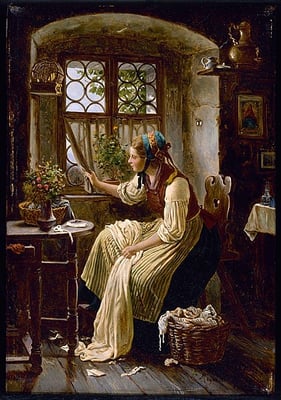
While this painting by Johann Georg Meyer wasn't specifically of Louise Mallard, "Young Woman Looking Through a Window" is a depiction of what Louise might have looked like as she realized her freedom.
"The Story of an Hour" Characters
The best stories have developed characters, which is the case in “The Story of an Hour,” too. Five characters make up the cast of “The Story of an Hour”:
Louise Mallard
Brently mallard.
- The doctor(s)
By exploring the details of each character, we can better understand their motivations, societal role, and purpose to the story.
From the opening sentence alone, we learn a lot about Louise Mallard. Chopin writes, “Knowing that Mrs. Mallard was afflicted with a heart trouble, great care was taken to break to her as gently as possible the news of her husband’s death.”
From that statement alone, we know that she is married, has a heart condition, and is likely to react strongly to bad news . We also know that the person who is sharing the bad news views Louise as delicate and sensitive. Throughout the next few paragraphs, we also learn that Louise is a housewife, which indicates that she would be part of the middle-to-upper class in the 1890s. Chopin also describes Louise’s appearance as “young,” “fair, calm face,” with lines of “strength.” These characteristics are not purely physical, but also bleed into her character throughout the story.
Louise’s personality is described as different from other women . While many women would be struck with the news in disbelief, Louise cries with “wild abandonment”—which shows how powerful her emotions are. Additionally, while other women would be content to mourn for longer, Louise quickly transitions from grief to joy about her husband’s passing.
Ultimately, Chopin uses Louise’s character to show readers what a woman’s typical experience within marriage was in the 1890s. She uses Louise to criticize the oppressive and repressive nature of marriage, especially when Louise rejoices in her newfound freedom.
Josephine is Louise’s sister . We never hear of Josephine’s last name or whether she is married or not. We do know that she has come with Richards, a friend of Brently’s, to break the news of his death to her sister.
When Josephine tells Louise the bad news, she’s only able to tell Louise of Brently’s death in “veiled hints,” rather than telling her outright. Readers can interpret this as Josephine’s attempt at sparing Louise’s feelings. Josephine is especially worried about her sister’s heart condition, which we see in greater detail later as she warns Louise, “You will make yourself ill.” When Louise locks herself in her room, Josephine is desperate to make sure her sister is okay and begs Louise to let her in.
Josephine is the key supporting character for Louise, helping her mourn, though she never knows that Louise found new freedom from her husband’s supposed death . But from Josephine’s actions and interactions with Louise, readers can accurately surmise that she cares for her sister (even if she’s unaware of how miserable Louise finds her life).
Richards is another supporting character, though he is described as Brently’s friend, not Louise’s friend. It is Richards who finds out about Brently Mallard’s supposed death while at the newspaper office—he sees Brently’s name “leading the list of ‘killed.’” Richards’ main role in “The Story of an Hour” is to kick off the story’s plot.
Additionally, Richard’s presence at the newspaper office suggests he’s a writer, editor, or otherwise employee of the newspaper (although Chopin leaves this to readers’ inferences). Richards takes enough care to double-check the news and to make sure that Brently’s likely dead. He also enlists Josephine’s help to break the news to Louise. He tries to get to Louise before a “less careful, less tender friend” can break the sad news to her, which suggests that he’s a thoughtful person in his own right.
It’s also important to note is that Richards is aware of Louise’s heart condition, meaning that he knows Louise Mallard well enough to know of her health and how she is likely to bear grief. He appears again in the story at the very end, when he tries (and fails) to shield Brently from his wife’s view to prevent her heart from reacting badly. While Richards is a background character in the narrative, he demonstrates a high level of friendship, consideration, and care for Louise.
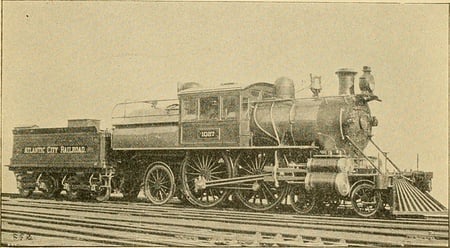
Brently Mallard would have been riding in a train like this one when the accident supposedly occurred.
Mr. Brently Mallard is the husband of the main character, Louise. We get few details about him, though readers do know he’s been on a train that has met with a serious accident. For the majority of the story, readers believe Brently Mallard is dead—though the end of “The Story of an Hour” reveals that he’s been alive all along. In fact, Brently doesn’t even know of the railroad tragedy when he arrives home “travel-stained.”
Immediately after Louise hears the news of his death, she remembers him fondly. She remarks on his “kind, tender hands” and says that Brently “never looked save with love” upon her . It’s not so much Brently as it’s her marriage to him which oppresses Louise. While he apparently always loved Louise, Louise only “sometimes” loved Brently. She constantly felt that he “impose[d] a private will” upon her, as most husbands do their wives. And while she realizes that Brently likely did so without malice, she also realized that “a kind intention or a cruel intention” makes the repression “no less a crime.”
Brently’s absence in the story does two things. First, it contrasts starkly with Louise’s life of illness and confinement. Second, Brently’s absence allows Louise to imagine a life of freedom outside of the confines of marriage , which gives her hope. In fact, when he appears alive and well (and dashes Louise’s hopes of freedom), she passes away.
The Doctor(s)
Though the mention of them is brief, the final sentence of the story is striking. Chopin writes, “When the doctors came they said she had died of heart disease—of the joy that kills.” Just as she had no freedom in life, her liberation from the death of her husband is told as a joy that killed her.
In life as in death, the truth of Louise Mallard is never known. Everything the readers know about her delight in her newfound freedom happens in Louise’s own mind; she never gets the chance to share her secret joy with anyone else.
Consequently, the ending of the story is double-sided. If the doctors are to be believed, Louise Mallard was happy to see her husband, and her heart betrayed her. And outwardly, no one has any reason to suspect otherwise. Her reaction is that of a dutiful, delicate wife who couldn’t bear the shock of her husband returned from the grave.
But readers can infer that Louise Mallard died of the grief of a freedom she never had , then found, then lost once more. Readers can interpret Louise’s death as her experience of true grief in the story—that for her ideal life, briefly realized then snatched away.

In "The Story of an Hour," the appearance of hearts symbolize both repression and hope.
“The Story of an Hour” Symbolism and Motifs
Symbols are any object, word, or other element that appear in the story and have additional meanings beyond. Motifs are elements from a story that gain meaning from being repeated throughout the narrative. The line between symbols and motifs is often hazy, but authors use both to help communicate their ideas and themes.
In “The Story of an Hour,” symbolism is everywhere, but the three major symbols present in the story are:
- The heart
- The house and the outdoors
- Joy and sorrow
Heart disease, referred to as a “heart condition” within the text, opens and closes the text. The disease is the initial cause for everyone’s concern, since Louise’s condition makes her delicate. Later, heart disease causes Louise’s death upon Brently’s safe return. In this case, Louise’s ailing heart has symbolic value because it suggests to readers that her life has left her heartbroken. When she believes she’s finally found freedom, Louise prays for a long life...when just the day before, she’d “had thought with a shudder that life might be long.”
As Louise realizes her freedom, it’s almost as if her heart sparks back to life. Chopin writes, “Now her bosom rose and fell tumultuously...she was striving to beat it back...Her pulses beat fast, and the coursing blood warmed and relaxed every inch of her body.” These words suggest that, with her newfound freedom, the symptoms of her heart disease have lifted. Readers can surmise that Louise’s diseased heart is the result of being repressed, and hope brings her heart back to life.
Unfortunately, when Brently comes back, so does Louise’s heart disease. And, although her death is attributed to joy, the return of her (both symbolic and literal) heart disease kills her in the end.
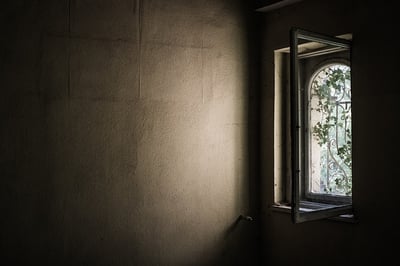
The House and the Outdoors
The second set of symbols are Louise’s house and the world she can see outside of her window. Chopin contrasts these two symbolic images to help readers better understand how marriage and repression have affected Louise.
First of all, Louise is confined to the home—both within the story and in general. For her, however, her home isn’t a place to relax and feel comfortable. It’s more like a prison cell. All of the descriptions of the house reinforce the idea that it’s closed off and inescapable . For instance, the front door is locked when Mr. Mallard returns home. When Mrs. Mallard is overcome with grief, she goes deeper inside her house and locks herself in her room.
In that room, however, Mrs. Mallard takes note of the outdoors by looking out of her window. Even in her momentary grief, she describes the “open square before her house” and “the new spring life.” The outdoors symbolize freedom in the story, so it’s no surprise that she realizes her newfound freedom as she looks out her window. Everything about the outside is free, beautiful, open, inviting, and pleasant...a stark contrast from the sadness inside the house .
The house and its differences from outdoors serve as one of many symbols for how Louise feels about her marriage: barred from a world of independence.
Joy and Sorrow
Finally, joy and sorrow are motifs that come at unexpected times throughout “The Story of an Hour.” Chopin juxtaposes joy and sorrow to highlight how tragedy releases Louise from her sorrow and gives her a joyous hope for the future.
At first, sorrow appears as Louise mourns the death of her husband. Yet, in just a few paragraphs, she finds joy in the event as she discovers a life of her own. Though Louise is able to see that feeling joy at such an event is “monstrous,” she continues to revel in her happiness.
It is later that, when others expect her to be joyful, Josephine lets out a “piercing cry,” and Louise dies. Doctors interpret this as “the joy that kills,” but more likely it’s a sorrow that kills. The reversal of the “appropriate” feelings at each event reveals how counterintuitive the “self-assertion which she suddenly recognized as the strongest impulse of her being” is to the surrounding culture. This paradox reveals something staggering about Louise’s married life: she is so unhappy with her situation that grief gives her hope...and she dies when that hope is taken away.
Key Takeaways: Kate Chopin's “The Story of an Hour”
Analyzing Chopin’s “The Story of an Hour” takes time and careful thought despite the shortness of the story. The story is open to multiple interpretations and has a lot to reveal about women in the 1890s, and many of the story’s themes, characters, and symbols critique women’s marriage roles during the period .
There’s a lot to dig through when it comes to “The Story of an Hour” analysis. If you’re feeling overwhelmed, just remember a few things :
- Events from Kate Chopin’s life and from social changes in the 1890s provided a strong basis for the story.
- Mrs. Louise Mallard’s heart condition, house, and feelings represent deeper meanings in the narrative.
- Louise goes from a state of repression, to freedom, and then back to repression, and the thought alone is enough to kill her.
Remembering the key plot points, themes, characters, and symbols will help you write any essay or participate in any discussion. Kate Chopin’s “The Story of an Hour” has much more to uncover, so read it again, ask questions, and start exploring the story beyond the page!

What’s Next?
You may have found your way to this article because analyzing literature can be tricky to master. But like any skill, you can improve with practice! First, make sure you have the right tools for the job by learning about literary elements. Start by mastering the 9 elements in every piece of literature , then dig into our element-specific guides (like this one on imagery and this one on personification .)
Another good way to start practicing your analytical skills is to read through additional expert guides like this one. Literary guides can help show you what to look for and explain why certain details are important. You can start with our analysis of Dylan Thomas’ poem, “Do not go gentle into that good night.” We also have longer guides on other words like The Great Gatsby and The Crucible , too.
If you’re preparing to take the AP Literature exam, it’s even more important that you’re able to quickly and accurately analyze a text . Don’t worry, though: we’ve got tons of helpful material for you. First, check out this overview of the AP Literature exam . Once you have a handle on the test, you can start practicing the multiple choice questions , and even take a few full-length practice tests . Oh, and make sure you’re ready for the essay portion of the test by checking out our AP Literature reading list!

Trending Now
How to Get Into Harvard and the Ivy League
How to Get a Perfect 4.0 GPA
How to Write an Amazing College Essay
What Exactly Are Colleges Looking For?
ACT vs. SAT: Which Test Should You Take?
When should you take the SAT or ACT?
Get Your Free

Find Your Target SAT Score
Free Complete Official SAT Practice Tests
How to Get a Perfect SAT Score, by an Expert Full Scorer
Score 800 on SAT Math
Score 800 on SAT Reading and Writing
How to Improve Your Low SAT Score
Score 600 on SAT Math
Score 600 on SAT Reading and Writing
Find Your Target ACT Score
Complete Official Free ACT Practice Tests
How to Get a Perfect ACT Score, by a 36 Full Scorer
Get a 36 on ACT English
Get a 36 on ACT Math
Get a 36 on ACT Reading
Get a 36 on ACT Science
How to Improve Your Low ACT Score
Get a 24 on ACT English
Get a 24 on ACT Math
Get a 24 on ACT Reading
Get a 24 on ACT Science
Stay Informed
Get the latest articles and test prep tips!

Ashley Sufflé Robinson has a Ph.D. in 19th Century English Literature. As a content writer for PrepScholar, Ashley is passionate about giving college-bound students the in-depth information they need to get into the school of their dreams.
Ask a Question Below
Have any questions about this article or other topics? Ask below and we'll reply!

IMAGES
VIDEO
COMMENTS
Looking for a critical analysis of The Story of an Hour? The essay on this page contains a summary of Kate Chopin’s short story, its interpretation, and feminist criticism. Find below The Story of an Hour critique together with the analysis of its characters, themes, symbolism, and irony.
Short Questions/Answers about/on “The Story of an Hour” by Kate Chopin. What is the significance of the title “The Story of an Hour” and how does it relate to the story’s themes?
This report demonstrates the analysis of the story The Story of an Hour by Kate Chopin. Focusing on what the prominent themes imply, and how are they relevant to the story. This ironically tragic yet powerful short story was [...]
Need help with “The Story of an Hour” in Kate Chopin's The Story of an Hour? Check out our revolutionary side-by-side summary and analysis.
‘The Story of an Hour’: plot summary. What happens in that brief hour, that story of an hour? A married woman, Mrs Louise Mallard, who has heart trouble, learns that her husband has died in a railroad accident.
Analysis of Kate Chopin’s The Story of an Hour. By NASRULLAH MAMBROL on July 28, 2021. Originally entitled “The Dream of an Hour” when it was first published in Vogue (December 1894), “The Story of an Hour” has since become one of Kate Chopin’s most frequently anthologized stories.
“The Story of an Hour” is one of the most famous works of Kate Chopin. This short reading narrates the story of a woman that feels optimistic about her husband’s death as she realizes that the rest of her life can be spent in freedom.
The Story of an Hour Critical Essays - eNotes.com. by Kate Chopin. Critical Overview. PDF Cite. A popular writer during her lifetime, Chopin is best known today for her psychological novel...
In this guide to Kate Chopin’s “The Story of an Hour,” we’ll discuss: A brief history of Kate Chopin and America the 1890s “The Story of an Hour” summary; Analysis of the key story elements in “The Story of an Hour,” including themes, characters, and symbols
Dive deep into Kate Chopin's The Story of an Hour with extended analysis, commentary, and discussion.